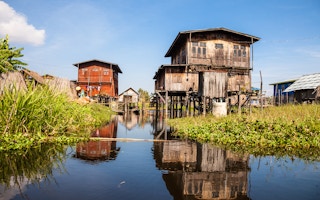All people, economies, and ecosystems depend on water. Yet water is often taken for granted, overused, abused, and poorly managed. The way we use and manage water leaves a considerable part of the global population without access, and threatens the integrity of ecosystems that are vital for a healthy planet and people.
Water insecurity keeps millions of people in poverty; it hampers human development and is a drag on economic growth. Water insecurity is worsened by population growth, economic growth, urbanisation, conflicts, and climate change. Such trends increase competition over water and put water resources at risk, just as water presents risks to growth and society if not managed sustainably.
The 2030 Agenda for Sustainable Development agreed by countries at the UN General Assembly in September 2015 recognises these trends and calls for an “all-of-society engagement and partnership” to address development challenges in a transformative and inclusive way, with the intention of “leaving no one behind.”
At the core of the 2030 Agenda are 17 Sustainable Development Goals (SDGs). The SDGs are ambitious, aspirational, and interconnected: to have any chance of success they demand tailor-made approaches and collaborative action.
Poverty reduction and growth are not possible without good water governance and management. Sustainable Development Goal No. 6 – “to ensure availability and sustainable management of water and sanitation for all” – is inextricably linked to and mutually dependent on most other goals, including poverty reduction, gender equality, climate, food, energy, health, cities, and ecosystems. SDG 6 provides a high level political commitment to an integrated approach to water security.
That high level political commitment will be on display in Yangon, Myanmar, on May 24, 2016. Convened by the Global Water Partnership (GWP) together with a range of partners, the “High Level Round Table on Water Security and the SDGs” in Myanmar will attract Ministers, parliamentarians, national and regional leaders and organisations, civil society, among many other actors.
Myanmar is undergoing an important water sector reform, making it an ideal country in transition to link water reform to the SDGs.
The main objective of the High Level Round Table is to contribute to the well-being of the people of Myanmar and South East Asia through setting the scene for improved governance and management of water resources and therefore sustainable and equitable development in the region. The outcomes of the meeting will be presented to the High Level Panel on Water to be held in June 2016.
“
Water is the basis of all economic development activities so the water-energy-food nexus must be understood.
Myanmar has frequently suffered from destructive earthquakes, water-related extreme weather events such as cyclones, flooding, as well as droughts, which resulted in losses and damages from landslides, with major challenges in terms water quality control and wastewater management – quite similar to challenges that other countries in South East Asia face.
With the decline of rainfall across the country and climate change impacts, underground aquifers are also declining, whereas water use continues to rise. Underground water supply will drop dramatically in the coming 30 years, according to the Myanmar Water Think Tank.
Water is the basis of all economic development activities so the water-energy-food nexus must be understood. Integrated water resources management principles should be applied in order to alleviate poverty, which can happen if the Myanmar National Water Policy is implemented, according to the Water Think Tank.
Water, of course, is not the only issue facing a country in which about a third of the population still live in extreme poverty. Almost three quarters of children in rural Myanmar grow up in homes without electricity. Only 29 percent of children graduate from secondary school.
Agriculture employs 65 percent of the country’s labour force, but suffers from low productivity. This is why the round table will address the links among five of the SDGs: SDG 5 (Gender), SDG 6 (Water and Sanitation), SDG 11 (Cities), SDG 13 (Climate Change), and SDG 17 (Partnerships).
Inclusive growth means greater investment in Myanmar’s greatest resource – its people – by ensuring education for all, health care for all, and energy for all. This will require policies to ensure public financing through tax collection, sound public spending, and investments that favour infrastructure and human development.
Infrastructure investments can spur private sector job growth and support more productive and labour-intensive economic activities, such as manufacturing and textile production.
Myanmar has shown strides towards integrated and sustainable water resources management. The event in Yangon could become a milestone in Myanmar’s new democracy, accelerating the consolidated Integrated Water Resources Management, Disaster Risk Reduction, and Water, Sanitation, and Hygiene activities that are ongoing under the guidance of the Government.
Each country needs to decide on its own national processes of integrating the SDGs into national plans and strategies, and its own entry points. Maybe Myanmar is a model for other countries on how to start.
Alice Bouman-Dentener, is chair, interim, Global Water Partnership. This post is republished from Inter Press Service News Agency.









